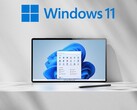1. Ads are everywhere
Microsoft is adopting a controversial practice by integrating "badges" into core operating system features such as the Start menu, search box, notifications panel, and File Explorer in Windows 11. These badges promote Microsoft services that supposedly enhance the current feature you are using, but in reality, they function as advertisements. Eliminating these ads would significantly improve Windows 11, making it more user-friendly.
Currently, these promotions are restricted to Microsoft's own services, such as OneDrive and Microsoft 365, which some users may find useful. There is no evidence to suggest that Microsoft intends to permit third-party advertisements through these badges, thereby limiting the intrusions to its ecosystem.
Are you a techie who knows how to write? Then join our Team! Wanted:
- News Writer
Details here
2. Older PCs may be left behind
A major issue during the Windows 11 launch has been its new hardware requirements. Instead of simply encouraging users to upgrade their existing systems, Microsoft appears to be pushing consumers towards purchasing new computers that come with Windows 11 pre-installed. The challenges include the need for a CPU from the past three years, the presence of a TPM security chip, and firmware capable of supporting Secure Boot.
While TPM chips and Secure Boot have been standard on PCs for several years, the recent CPU requirement poses the biggest obstacle for many users looking to upgrade. This requirement effectively excludes a large number of older, yet still functional machines from running Windows 11, forcing users to consider investing in new hardware to access the latest operating system.
If you're considering purchasing a laptop with Windows 11 pre-installed, you might want to check out the Acer Aspire 3 currently on sale for $299 on Amazon.
3. Taskbar and Start menu are less useful
With each new version of Windows, the taskbar and Start menu often become focal points of user feedback. Windows 10 offers wider and more informative taskbar buttons, along with the flexibility to place the taskbar on the side, top, or bottom of the screen. In contrast, Windows 11 lacks these options. In Windows 10, taskbar entries stay in the same place, while in Windows 11, using the default center alignment causes icons, including the Start button, to shift as apps are opened and closed. Although you can left-align the taskbar in Windows 11, this only addresses the issue of shifting icons.
The new Windows 11 Start menu also underperforms in showing recently or frequently used apps, instead offering vague "Suggested" apps that are not as useful as Windows 10’s clear sections. The icons in Windows 11 do not display information about the apps, unlike the informative tiles in Windows 10. Windows 10 also provides immediate access to Power options (Shut Down, Restart, Sleep) and Settings directly from the Start menu, whereas in Windows 11, these options are not included by default but can be added back through settings customization.


 Deutsch
Deutsch English
English Español
Español Français
Français Italiano
Italiano Nederlands
Nederlands Polski
Polski Português
Português Русский
Русский Türkçe
Türkçe Svenska
Svenska Chinese
Chinese Magyar
Magyar





